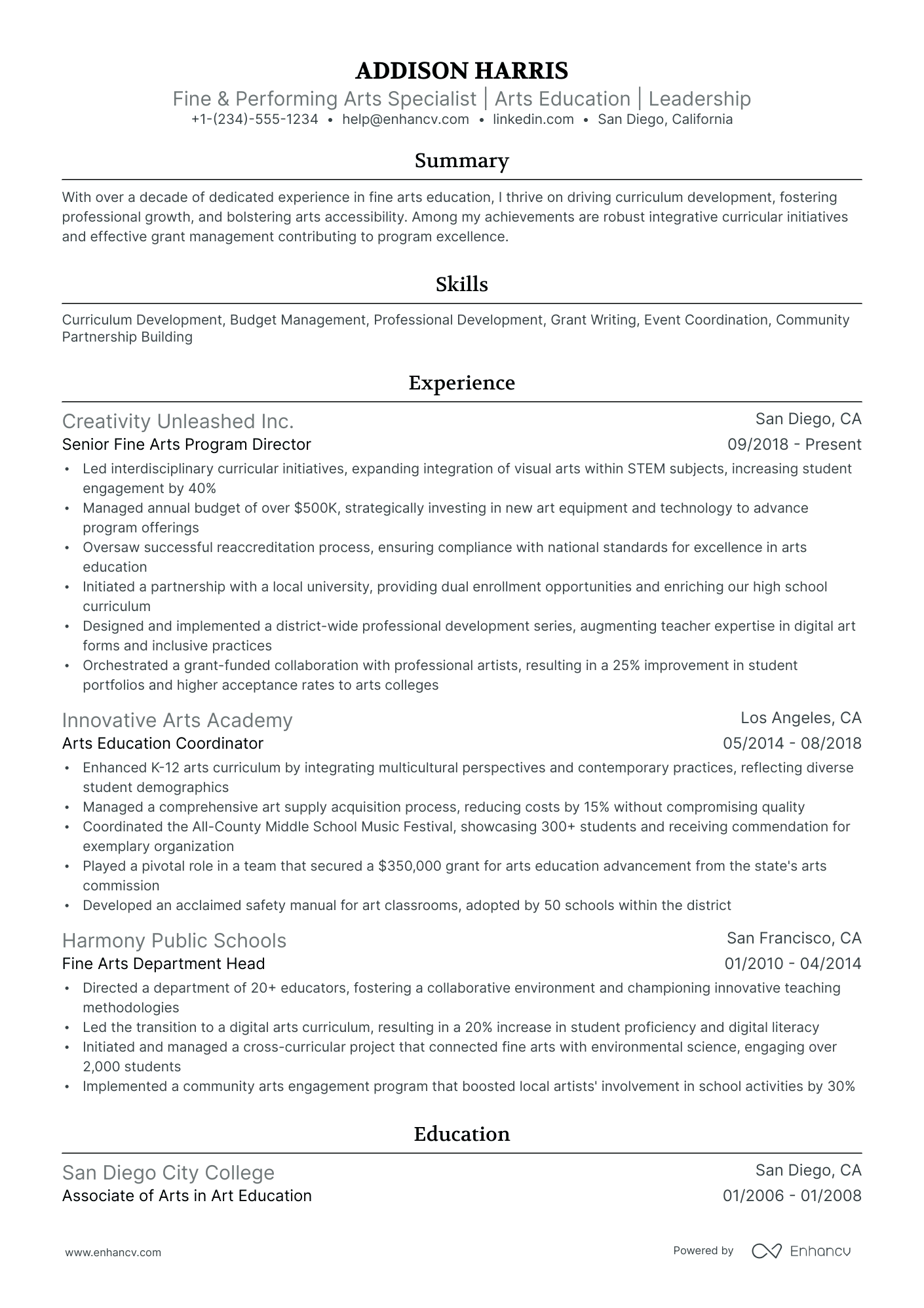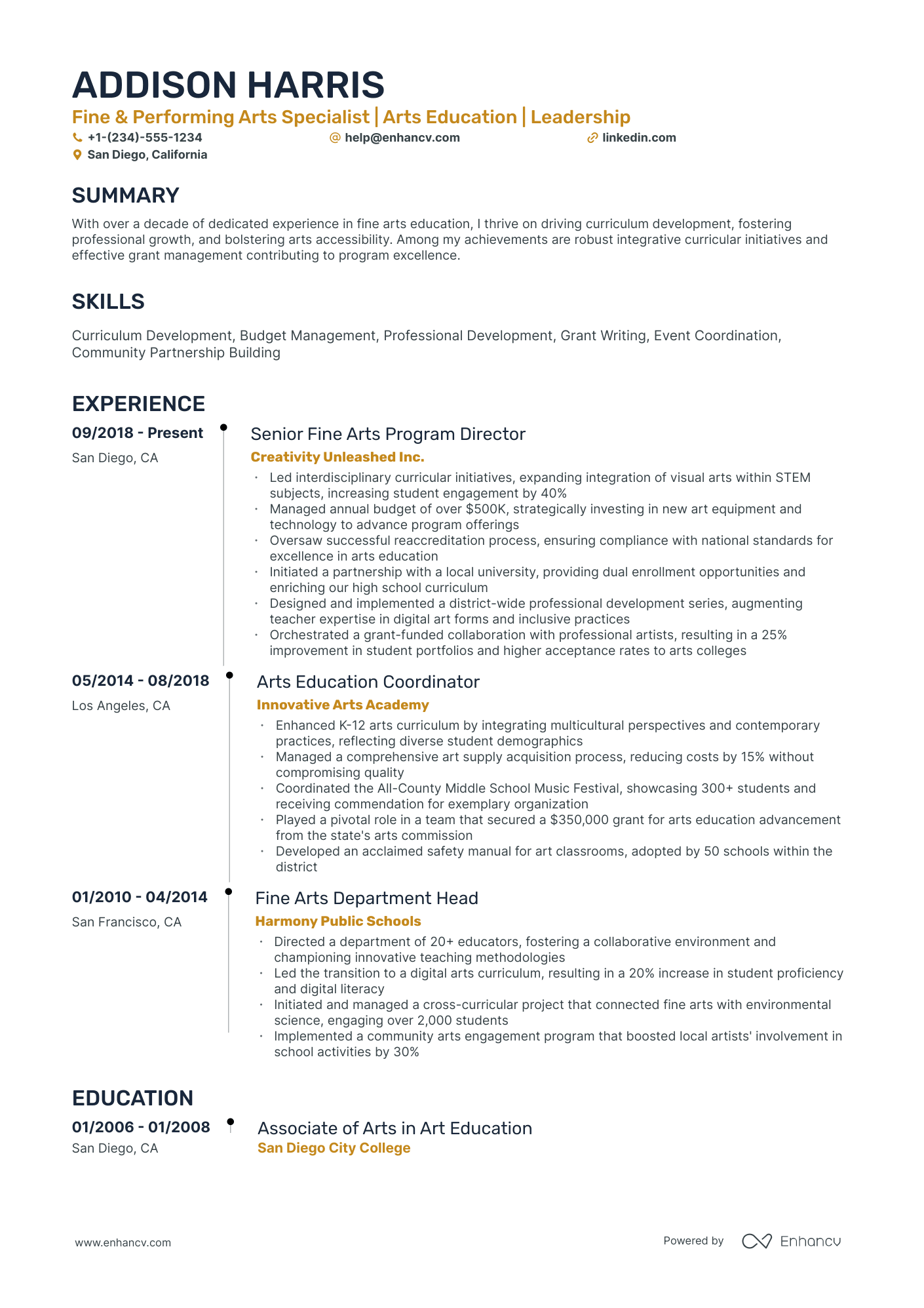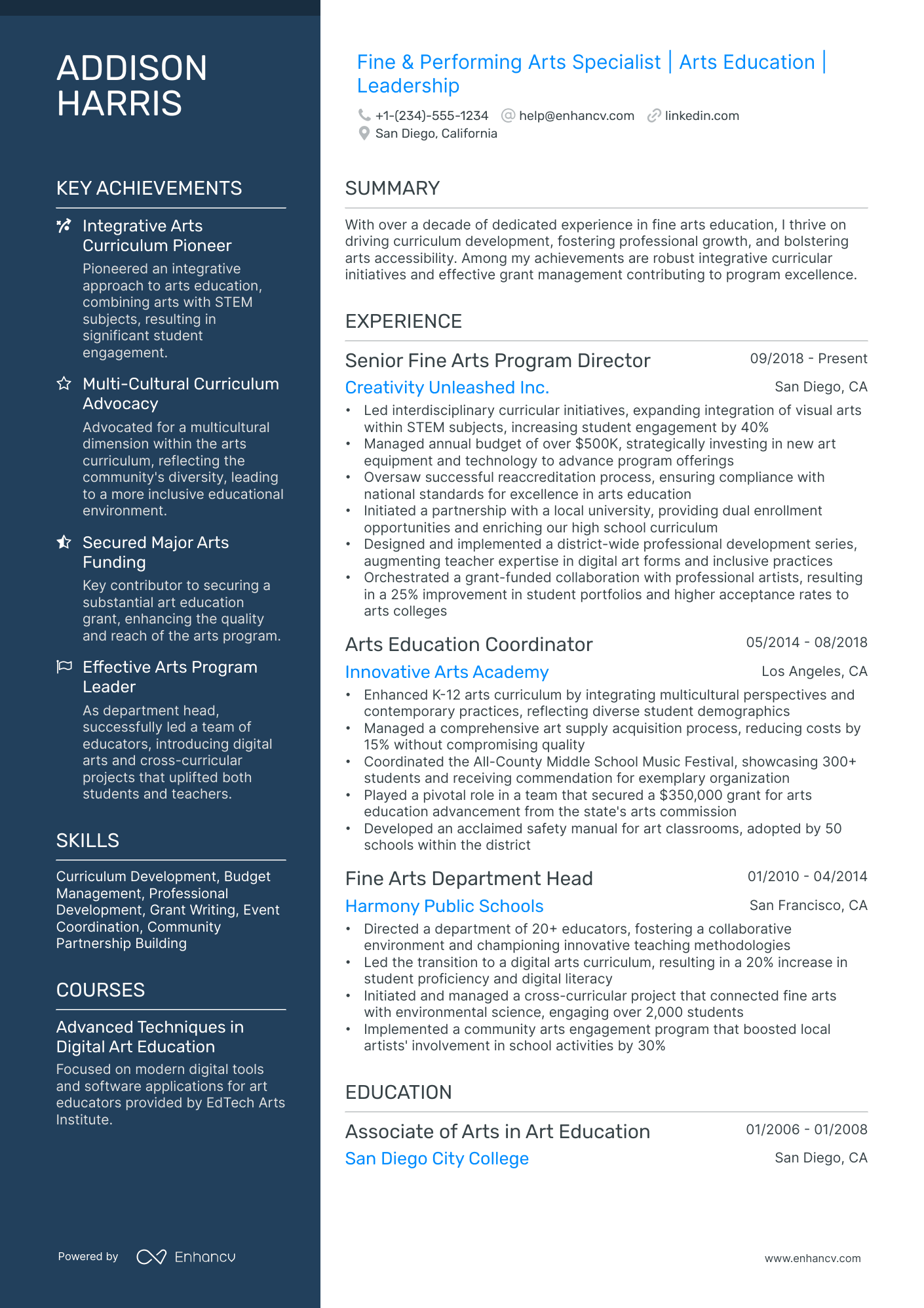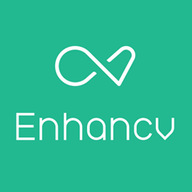As a performing artist, one resume challenge is effectively translating the breadth of your artistic experiences, which may include varied roles and eclectic performances, into a coherent career narrative. Our guide will provide you with structured techniques to articulate your artistic journey clearly, ensuring your resume resonates with diverse audiences, from casting directors to grant committees.
- Apply best practices from professional resumes to spotlight your application;
- Quantify your professional experience with achievements, career highlights, projects, and more;
- Write an eye-catching performing arts resume top one-third with your header, summary/objective, and skills section;
- Fill in the gaps of your experience with extracurricular, education, and more vital resume sections.
We've selected, especially for you, some of our most relevant performing arts resume guides. Getting you from thinking about your next career move to landing your dream job.
Don't stress out over your performing arts resume format
Remember, the elaborate design of your performing arts resume isn't what impresses recruiters most. They are primarily searching for candidates who meet the job requirements. The main aim of your resume should be to clearly and concisely explain why employers should hire you.
Here are four straightforward steps to consider in your performing arts resume design:
- Organize your resume based on experience: Start with your most recent roles. Besides using reverse chronological order, choose jobs relevant to the position you're applying for.
- Include your contact details (and portfolio or LinkedIn link) in your resume's header to ensure recruiters can easily reach you. If considering adding a professional photo, check acceptable practices in different countries first.
- Don't omit essential performing arts resume sections such as the summary or objective, experience, and education. These sections should reflect your career progression and align with job requirements.
- Maintain conciseness in your resume. For those with less than ten years of experience, a one-page format is advisable.
Regarding the format to submit your performing arts resume, PDF is preferable. PDFs are more likely to maintain their formatting when processed through recruitment software or ATS, saving you time in the application process.
When selecting a font for your performing arts resume, consider the following:
- Choose ATS-friendly fonts such as Exo 2, Volkhov, Lato, etc., to keep your resume's content legible;
- All serif and sans-serif fonts are easily readable by ATS;
- While Arial and Times New Roman are common choices, opting for unique typography can help your resume stand out.
Concerned about ATS compatibility with charts and infographics? Our recent study has debunked this and other myths.
Customize your resume for the market – a Canadian format, for example, might vary in structure.
Upload & Check Your Resume
Drop your resume here or choose a file. PDF & DOCX only. Max 2MB file size.
PRO TIP
The more time and effort you've put into obtaining the relevant certificate, the closer to the top it should be listed. This is especially important for more senior roles and if the company you're applying for is more forward-facing.
Performing arts resume sections to answer recruiters' checklists:
- Header to help recruiters quickly allocate your contact details and have a glimpse over your most recent portfolio of work
- Summary or objective to provide an overview of your career highlights, dreams, and goals
- Experience to align with job requirements and showcase your measurable impact and accomplishments
- Skills section/-s to pinpoint your full breadth of expertise and talents as a candidate for the performing arts role
- Education and certifications sections to potentially fill in any gaps in your experience and show your commitment to the industry
What recruiters want to see on your resume:
- Performance Experience: Notable roles, productions, and directors/choreographers you have worked with.
- Training: Formal education in the performing arts, such as degrees or certifications, along with workshops and masterclasses.
- Special Skills: Unique talents such as dance styles, musical instruments, acrobatics, or fluency in multiple languages.
- Awards and Accolades: Recognition from the industry, such as awards or nominations for performances.
- Professional Headshots/Reels: High-quality, current images and video clips showcasing your performances and abilities.
Five dos for building your performing arts resume experience section
The best strategic approach to your performing arts resume experience section is to support your particular responsibilities with actions and achievements.
For example, you could list:
- Up to six responsibilities in your day-to-day work, supported by why they're important for your role, department, or organization;
- Experience items that have helped you sustain and enhance your technical knowledge within the field, or, perhaps, have helped you grow as a professional;
- Any metrics that pinpoint your success within your past roles;
- How you've solved specific problems in your day-to-day work;
- Strategies and solutions you've implemented for growth - and how that growth was measured.
The performing arts resume experience is your best shot at making a good first impression on recruiters. That's why we've included some real-world professional examples to get you thinking about how you present your experience:
- Led the development and production of the theater's highly-praised annual musical, overseeing a multi-disciplinary team of 50 members, resulting in sold-out performances.
- Implemented a comprehensive digital marketing strategy for promoting shows, which boosted ticket sales by 35% within the first year.
- Choreographed and directed a culturally diverse cast for an avant-garde interpretation of 'Phantom of the Opera', receiving critical acclaim and advancing the theater's reputation.
- Orchestrated community outreach programs, including free performance days, increasing local engagement by 40%.
- Initiated and managed collaborations with local schools to introduce performing arts programs, heightening student enrollment in arts classes by 25%.
- Spearheaded the theater's transition to a more sustainable model by incorporating LED stage lighting, cutting annual energy costs by 20%.
- Curated an internationally recognized dance festival, attracting over 10,000 attendees and garnering extensive media coverage.
- Developed an innovative digital platform for ticket sales that streamlined the booking process, enhancing customer satisfaction and increasing online ticket sales by 50%.
- Expanded the center's repertoire by commissioning new works from emerging artists, leading to a 30% increase in annual subscriptions.
- Coordinated the logistical and technical aspects of over 200 live performances, significantly reducing setup times by 15% through improved processes.
- Negotiated contracts with performers and vendors, resulting in improved terms that saved the company an average of $5,000 per event.
- Fostered a collaborative environment that enabled the production team to meet tight deadlines for back-to-back performances during peak seasons.
- Initiated a digital archiving project for past performances, enhancing the accessibility for researchers and the public resulting in a 20% increase in educational use.
- Oversaw the successful adaptation of literary classics for the stage, cultivating a new audience demographic and expanding regular patronage by 15%.
- Managed tight production budgets, ensuring optimal use of financial resources and continuously delivering productions under budget by an average of 10%.
- Ambitiously led a cross-functional team to develop and stage a groundbreaking multimedia performance piece that increased venue visitation by 20%.
- Implemented an artist-in-residence program that nurtured talent and resulted in two original productions being picked up for regional tours.
- Leveraged social media to create buzz around performances, which contributed to a 15% year-over-year increase in overall ticket revenue.
- Conducted comprehensive market analysis to identify and fill gaps in the performing arts program, introducing a series of successful new genres and formats.
- Cultivated strategic partnerships with local businesses to sponsor performances, boosting annual sponsorship proceeds by 30%.
- Implemented staff development programs which enhanced team skill sets and led to a 25% increase in overall performance quality as rated by audience surveys.
- Launched an annual arts festival that became a flagship event for the city, increasing visibility for the performers and drawing in a 50% larger audience each year.
- Negotiated with global performing arts networks for exclusive content, elevating the company's profile and subscriber base by 20% over three years.
- Led a multicultural team to foster an inclusive programming strategy that appealed to a broader audience spectrum, lifting average show attendance by 25%.
Quantifying impact on your resume
- Include the number of performances in which you participated to demonstrate experience and dedication.
- List the size of audiences you have performed for to illustrate your ability to handle high-pressure situations.
- Specify the number of projects you collaborated on, highlighting your teamwork and networking skills.
- Mention the percentage of ticket sales or revenue increase attributed to shows you were involved in, showing direct business impact.
- Detail the number of leading roles you've had to emphasize your leadership and responsibility.
- Count the number of special skills or techniques you possess to showcase versatility and adaptability.
- Note the number of awards or recognitions you have received as a measure of excellence and peer recognition.
- Track and report the hours of rehearsal or training per week to indicate your work ethic and dedication.
Action verbs for your performing arts resume
Guide for performing arts professionals kicking off their career
Who says you can't get that performing arts job, even though you may not have that much or any experience? Hiring managers have a tendency to hire the out-of-the-blue candidate if they see role alignment. You can show them why you're the best candidate out there by:
- Selecting the functional skill-based or hybrid formats to spotlight your unique value as a professional
- Tailoring your performing arts resume to always include the most important requirements, found towards the top of the job ad
- Substituting the lack of experience with other relevant sections like achievements, projects, and research
- Pinpoint both achievements and how you see yourself within this specific role in the performing arts resume objective.
Recommended reads:
PRO TIP
List your educational qualifications and certifications in reverse chronological order.
Performing arts skills and achievements section: must-have hard and soft skills
A key principle for your performing arts resume is to prominently feature your hard skills, or the technologies you excel in, within the skills section. Aim to list several hard skills that are in line with the job's requirements.
When it comes to soft skills, like interpersonal communication abilities and talents, they're trickier to quantify.
Claiming to be a good communicator is one thing, but how can you substantiate this claim?
Consider creating a dedicated "Strengths" or "Achievements" section. Here, you can describe how specific soft skills (such as leadership, negotiation, problem-solving) have led to concrete achievements.
Your performing arts resume should reflect a balanced combination of both hard and soft skills, just as job requirements often do.
Top skills for your performing arts resume:
Acting Techniques
Stage Management Software
Lighting Design Tools
Sound Engineering Equipment
Choreography Software
Costume Design Tools
Video Editing Software
Music Composition Software
Scriptwriting Tools
Performance Analysis Software
Communication
Team Collaboration
Creativity
Adaptability
Time Management
Problem Solving
Emotional Intelligence
Public Speaking
Critical Thinking
Networking
PRO TIP
Mention specific courses or projects that are pertinent to the job you're applying for.
Listing your education and certifications on your performing arts resume
Don't underestimate the importance of your resume education section . As it may hint at various skills (and experience) that are relevant to the job. When writing your education section:
- Include only higher education degrees with information about the institution and start/end dates
- If you're in the process of obtaining your degree, include your expected graduation date
- Consider leaving off degrees that aren't relevant to the job or industry
- Write a description of your education if it presents you with an opportunity to further showcase your achievements in a more research-focused environment
When describing your certifications on your resume, always consider their relevancy to the role. Use the same format to describe them as you would for your education. If you're wondering what the best certificates out there are for performing arts roles, check out the list below.
The top 5 certifications for your performing arts resume:
- Associate of Trinity College London (ATCL) - Trinity College London
- Licentiate of the Royal Academy of Music (LRAM) - Royal Academy of Music
- Licentiate of Trinity College London (LTCL) - Trinity College London
- Certificate of Performance (CertPerf) - Australian Music Examinations Board
- National Professional Qualification for Headship (NPQH) - National College for Teaching and Leadership
PRO TIP
Bold the names of educational institutions and certifying bodies for emphasis.
Recommended reads:
The ideal performing arts candidate resume summary or objective
You may have heard that your resume top one-third plays an important part in your application.
It basically needs to show strong alignment with the job advert, your unique skill set, and your expertise.
Both the resume summary and resume objective could be used to ensure you've shown why you're the best candidate for the role.
Use the:
- Resume objective to pinpoint your current successes, that are applicable to the field, and your vision for your career. Remember to state how you see yourself growing within this new career opportunity.
- Resume summary as an instrument to pinpoint what is most applicable and noteworthy form your professional profile. Keep your summary to be no more than five sentences long.
At the end of the day, the resume summary or objective is your golden opportunity to shine a light on your personality as a professional and the unique value of what it's like to work with you.
Get inspired with these performing arts resume examples:
Resume summaries for a performing arts job
- Dynamic professional with 10 years of dedicated experience in musical theater stage management, adept at coordinating complex productions and ensuring seamless transitions between scenes. Holds a record of successful management for over 50 stage shows including sold-out performances at renowned venues such as New York’s Broadway theaters.
- Veteran dance instructor and choreographer with 15 years of extensive experience training students at the prestigious Danceworks Studio, crafting unique and memorable performances that have won numerous national competitions, including the National Dance Challenge.
- Energetic marketing strategist transitioning to the performing arts sector, bringing over 8 years of experience in devising and executing successful branding campaigns, deeply passionate about leveraging storytelling skills and marketing expertise to promote and enhance the visibility of emerging performance artists.
- Accomplished software developer aspiring to pivot into the world of playwriting and stage production, armed with a decade-long career in tech innovation, looking to infuse the performing arts with fresh narratives and harnessing the power of digital platforms to reach new audiences.
- Aspiring performer, aiming to hone my acting and singing abilities in a dynamic theater environment, enthusiastic to apply my extensive public speaking background and my passion for storytelling to captivate audiences and contribute to memorable theatrical experiences.
- Determined recent graduate with a degree in Performance Studies from the University of California, eager to apply my academic knowledge, my skills in improvisation, and my persistent dedication to join a professional dance troupe, aspiring to inspire through movement and creativity.
Optimize your resume summary and objective for ATS
Drop your resume here or choose a file.
PDF & DOCX only. Max 2MB file size.
Miscellaneous performing arts resume sections for a more personalized approach
Your performing arts resume can reflect even more upon your personality and best qualities - that is if you decide on including a couple of additional resume sections to support your application.
Some of the best-accepted industry-wide choices include the:
- Resume projects - getting into the outcomes of your most important work, so far;
- Languages on your resume - detailing your proficiency level;
- Special recognitions - dedicated to your most prominent industry awards;
- Hobbies and interests - defining how you spend your free time.
Key takeaways
- The format and layout of your performing arts resume should reflect on both your career and what matters most to the job you're applying for;
- Use the resume summary and objective to hint at your most prominent accomplishments;
- Always be specific about your experience and consider what value each bullet you curate adds to your performing arts application;
- Consider how your academic background and technical capabilities could further showcase your alignment to the role;
- Your soft skills should contribute to your overall performing arts profile - aligning your personality with skills and results.











